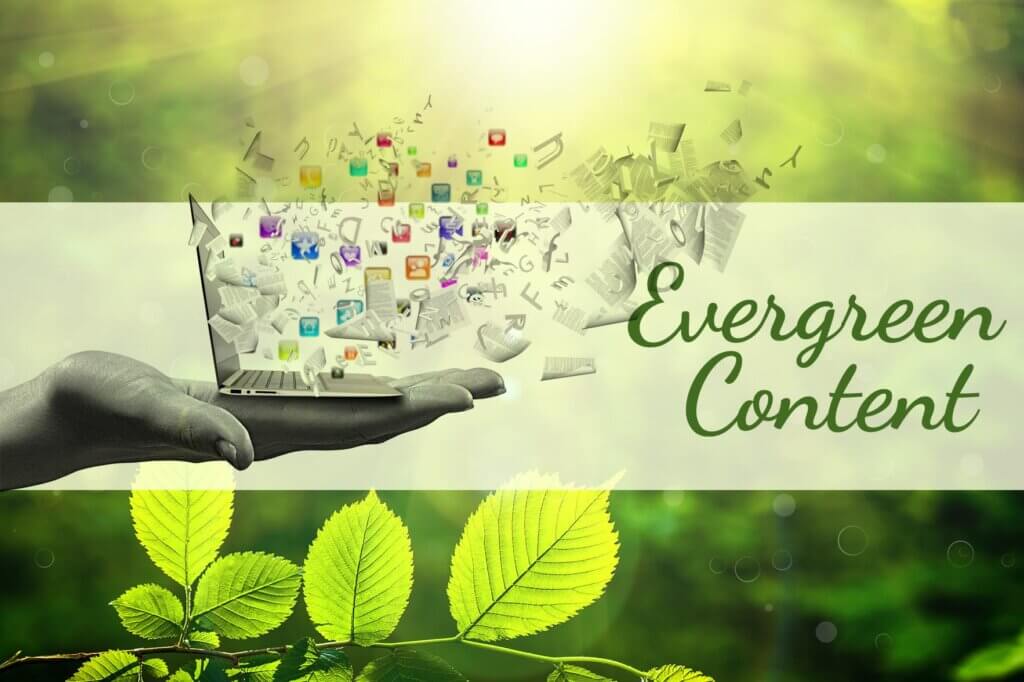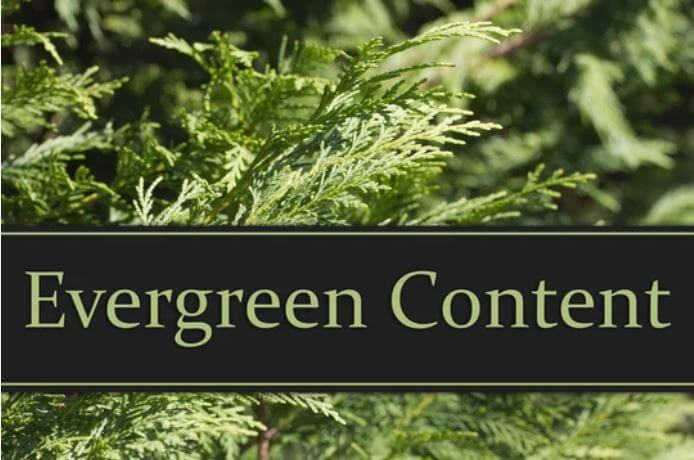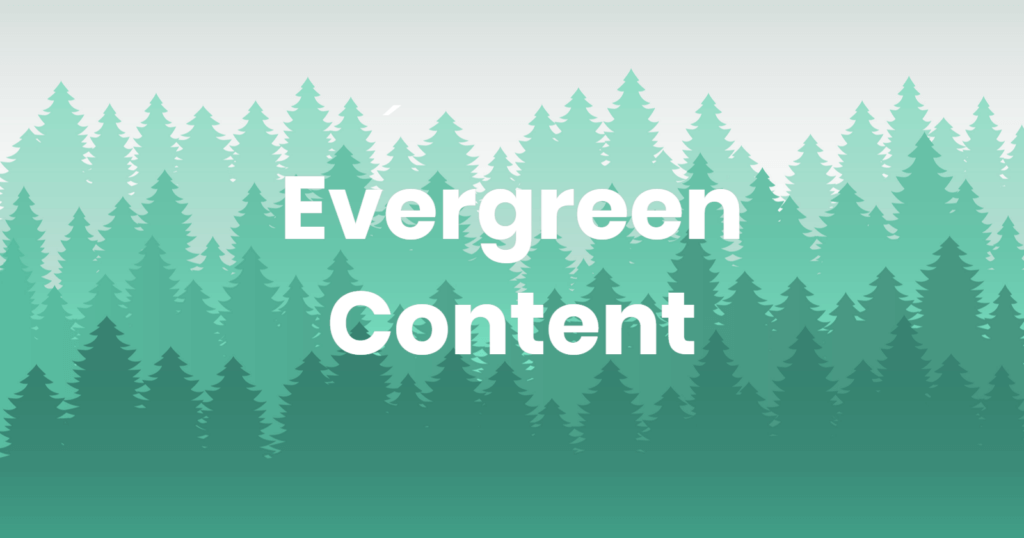Evergreen Content
Introduction
Evergreen content is content that never goes out of date and remains relevant and helpful to readers for a long time. It is designed to provide long-term value and can be enjoyed by readers over an extended period. It’s essential to any content marketing strategy for building brand awareness, driving traffic, and increasing engagement.
Why is Evergreen Content Important?
- Provides Long-Term Value: Evergreen content offers value to readers for an extended period. As a result, it helps build long-lasting relationships with your audience, increasing their loyalty, and trust toward your brand.
- Increases Organic Traffic: Evergreen content is highly shareable, and as a result, it attracts organic traffic to your website. It also generates backlinks, which increases your website’s domain authority and improves its search engine rankings.
- Cost-Effective: Evergreen content requires a one-time investment but continues to deliver results over an extended period. It is a cost-effective way of driving traffic, generating leads, and increasing conversions.
- Builds Brand Authority: Evergreen content showcases your expertise in a particular niche, and as a result, it builds your brand’s authority and credibility.
Characteristics of Evergreen Content
Evergreen content is an essential part of any content marketing strategy. It’s a type that remains relevant and helpful to readers for an extended period. Unlike news-based content that is time-sensitive and has a short lifespan, evergreen content provides long-term value to your audience. This article will discuss the characteristics of evergreen content that make it a valuable asset for any business.
Timelessness
The first characteristic of evergreen content is timelessness. This means that the content remains relevant even years after it’s published. Evergreen content is not tied to a particular date or event and can be consumed by your audience at any time. Example of evergreen content includes how-to guides, tutorials, and lists of tips or best practices.
Relevance
The second characteristic of evergreen content is relevance. Evergreen content addresses a topic or a problem that is ever-present and relevant to your target audience. Researching your audience and identifying what interests add is essential pressing this topic; you can create content that provides long-term value to your audience and drives traffic to your website.
Quality
The third characteristic of evergreen content is quality. Evergreen content is designed to provide value to your audience, so it must be high quality. The content should be well-researched, well-written, and visually appealing. High-quality evergreen content is more likely to be shared by your audience and generate backlinks, which can improve your website’s search engine rankings.
Search Engine Optimization
The fourth characteristic of evergreen content is search engine optimization (SEO). Evergreen content is designed to attract organic traffic to your website, so it should be optimized for search engines. The content should include relevant keywords, meta descriptions, and title tags. By optimizing your evergreen content for search engines, you can improve your website’s visibility and attract more traffic to your website.
Types of Evergreen Content
Evergreen content is a valuable asset for any business as it provides long-term value to your audience and drives traffic to your website. It’s content that remains relevant and useful to readers for an extended period. There are several types of evergreen content that you can create for your business. This article will discuss the different kinds of evergreen content and how they can benefit your business.
How-To Guides
How-to guides provide step-by-step instructions on how to perform a particular task or achieve a specific goal. These guides can educate your audience and provide them with valuable information. How-to guides are a great way to demonstrate your expertise in a particular field and build your brand’s authority. They can also attract traffic to your website as people search for solutions to their problems.
Tutorials
Tutorials provide a detailed explanation of how to use a particular product or service. These tutorials can demonstrate the features and benefits of your product or service. Tutorials are a great way to educate your audience and provide valuable information. They can also improve the user experience of your product or service and reduce the number of support requests.
Lists and Rankings
Lists and rankings give your audience a list of the best products or services in a particular niche. These lists can provide your audience with valuable information and attract traffic to your website. Lists and rankings are a great way to showcase your expertise in a particular field and build your brand’s authority.
Expert Roundups
Expert roundups feature insights and opinions from experts in a particular field. These roundups can give your audience valuable insights and build your brand’s authority. Expert roundups can attract traffic to your website as people search for information and opinions from experts in a particular field.
Glossaries and Definitions
Glossaries and definitions provide your audience with a list of terms and definitions related to a particular topic. These glossaries can educate your audience and provide them with valuable information. Dictionaries and reports can also attract traffic to your website as people search for definitions and explanations of terms related to your niche.
Frequently Asked Questions (FAQs)
FAQs answer common questions your audience may have about your product or service. These FAQs can be used to provide your audience with valuable information and improve their experience with your brand. FAQs can also reduce the number of support requests and improve the efficiency of your customer support team.
Case Studies
Case studies provide real-world examples of how your product or service has helped your customers achieve their goals. These case studies can demonstrate the value of your product or service and build trust with your audience. Case studies can also attract traffic to your website as people search for solutions to their problems.
Evergreen content is a valuable asset for any business. The different types of evergreen content provide additional benefits to your business, including attracting traffic to your website, educating your audience, improving the user experience of your product or service, and building your brand’s authority. Creating high-quality evergreen content can provide long-term value to your audience and drive traffic to your website.
Creating Evergreen Content
Evergreen content is a type of content that remains relevant and useful to readers for an extended period. It’s an essential part of any content marketing strategy and can provide long-term value to your audience. In this article, we will discuss the process of creating evergreen content and provide tips on creating high-quality content that provides value to your audience.
Researching Your Topic
The first step in creating evergreen content is researching your topic. Understanding your audience and identifying the issues that interest them is essential. This involves conducting keyword research, analyzing search trends, and monitoring social media conversations. By understanding your audience’s needs and interests, you can create content that provides long-term value to them.
Writing Evergreen Content
Once you’ve identified your topic, it’s time to start writing your evergreen content. When writing evergreen content, it’s essential to focus on the quality of the content. The content should be well-researched, well-written, and visually appealing. Here are some tips for writing high-quality evergreen content:
- Use a clear and concise writing style
- Use subheadings and bullet points to break up the content
- Use images and videos to make the content more engaging
- Use examples and case studies to demonstrate the points made in the content
- Use internal and external links to provide additional value to the reader
Optimizing Your Evergreen Content
Once you’ve written your evergreen content, optimizing it for search engines is essential. This involves using relevant keywords, optimizing meta descriptions and title tags, and ensuring the content is mobile-friendly. Here are some tips for optimizing your evergreen content:
- Use relevant keywords in the content
- Use descriptive meta descriptions and title tags
- Ensure that the content is mobile-friendly
- Use internal and external links to improve the content’s authority
- Ensure that the content is easily shareable on social media
Updating Your Evergreen Content
Finally, it’s essential to update your evergreen content regularly. This ensures that the content remains relevant and valuable to your audience. Here are some tips for updating your evergreen content:
- Monitor search trends and update the content accordingly
- Update the content with new statistics, examples, and case studies
- Update the meta descriptions and title tags to reflect any changes to the content
- Monitor social media conversations and update the content to address any new concerns or questions
Evergreen content is a valuable asset for any business. By researching your topic, writing high-quality content, optimizing the content for search engines, and updating the content regularly, you can create evergreen content that provides long-term value to your audience. Creating high-quality evergreen content can drive traffic to your website, generate leads, and increase conversions.
Promoting Evergreen Content
Evergreen content is a type of content that remains relevant and useful to readers for an extended period. It’s an essential part of any content marketing strategy and can provide long-term value to your audience. However, creating evergreen content is only half the battle. You need to promote your content effectively to get the most out of it. In this article, we will discuss the process of fostering evergreen content and provide tips on how to get the most out of your content.
Social Media
Social media is a powerful tool for promoting evergreen content. By sharing your content on social media, you can reach a wider audience and attract traffic to your website. Here are some tips for promoting evergreen content on social media:
- Share your content on multiple platforms, including Facebook, Twitter, and LinkedIn
- Use relevant hashtags to increase visibility
- Schedule your posts at optimal times to maximize engagement
- Use eye-catching images and videos to make your content more engaging
- Engage with your audience by responding to comments and questions
Email Marketing
Email marketing is another effective way to promote evergreen content. By sending your content to your email list, you can keep your audience informed and engaged with your brand. Here are some tips for promoting evergreen content through email marketing:
- Segment your email list to ensure that your content is relevant to your audience
- Use catchy subject lines to increase open rates
- Include a clear call to action in your email to encourage engagement
- Use a visually appealing email template to make your content more engaging
- Monitor your email analytics to improve your email marketing strategy
Influencer Outreach
Influencer outreach involves contacting influencers in your industry and asking them to promote your content to their audience. Influencers can help you reach a wider audience and attract traffic to your website. Here are some tips for influencer outreach:
- Identify relevant influencers in your industry using tools like BuzzSumo and Followerwonk
- Reach out to influencers with a personalized message and explain why your content would be appropriate for their audience.
- Offer value to the influencer, such as a guest post or a social media shoutout.
- Follow up with the influencer to ensure that they have received your message.
Paid Advertising
Paid advertising is another effective way to promote evergreen content. By using paid advertising, you can reach a wider audience and attract traffic to your website. Here are some tips for paid advertising:
- Use relevant keywords to target your audience
- Use eye-catching images and videos to make your content more engaging
- Use clear and concise ad copy to encourage engagement
- Monitor your ad analytics to improve your paid advertising strategy
Link Building
Link building involves getting other websites to link back to your evergreen content. This can improve your website’s search engine rankings and attract traffic. Here are some tips for link building:
- Reach out to relevant websites and ask them to link back to your evergreen content
- Offer to guest post on other websites and include a link back to your evergreen content
- Monitor your backlink profile to ensure that your website’s authority is improving
Promoting evergreen content is essential for getting the most out of your content marketing strategy. Using social media, email marketing, influencer outreach, paid to advertise, and link building, you can attract traffic to your website, generate leads, and increase conversions. By promoting your evergreen content effectively, you can ensure that your content provides long-term value to your audience.
Examples of Evergreen Content
Evergreen content is a type of content that remains relevant and useful to readers for an extended period. It’s an essential part of any content marketing strategy and can provide long-term value to your audience. This article will discuss some examples of content and how they can benefit your business.
How-To Guides
How-to guides are one of the most popular types of evergreen content. They provide step-by-step instructions on performing a particular task or achieving a specific goal. How-to guides are a great way to educate your audience and provide valuable information. Examples of how-to guides include:
- How to Write a Resume
- How to Make a Cake
- How to Create a Budget
- How to Start a Business
- How to Paint a Room
Tutorials
Tutorials are another popular type of evergreen content. They provide a detailed explanation of how to use a particular product or service. Tutorials are a great way to demonstrate the features and benefits of your product or service. Examples of tutorials include:
- How to Use Photoshop
- How to Use Excel
- How to Use a DSLR Camera
- How to Use a CRM Software
- How to Use Social Media
Lists and Rankings
Lists and rankings are other popular types of evergreen content. They give your audience a curated list of the best products or services in a particular niche. Lists and rankings are a great way to provide your audience with valuable information and attract traffic to your website. Examples of lists and rankings include:
- Top 10 Best Places to Travel
- Top 5 Best Books on Marketing
- 15 Best Apps for Productivity
- Top 20 Best Kitchen Gadgets
- 10 Best Online Courses for Learning a New Skill
Expert Roundups
Expert roundups are a great way to give your audience valuable insights and build your brand’s authority. They feature insights and opinions from experts in a particular field. Expert roundups can attract traffic to your website as people search for information and opinions from experts in a specific area. Examples of expert roundups include:
- Top SEO Tips from Industry Experts
- Top Marketing Strategies from Industry Experts
- Best Leadership Practices from Industry Experts
- Top Design Trends from Industry Experts
- Best Investment Advice from Industry Experts
Glossaries and Definitions
Glossaries and definitions provide your audience with a list of terms and definitions related to a particular topic. They are a great way to educate your audience and provide valuable information. Glossaries and reports can also attract traffic to your website as people search for definitions and explanations of terms related to your niche. Examples of dictionaries and words include:
- Digital Marketing Glossary
- SEO Terminology
- Investing Terms and Definitions
- Tech Jargon Explained
- Startup Lingo Defined
Frequently Asked Questions (FAQs)
FAQs answer common questions your audience may have about your product or service. They are a great way to provide your audience with valuable information and improve their experience with your brand. FAQs can also reduce the number of support requests and improve the efficiency of your customer support team. Examples of FAQs include:
- FAQ about Product or Service
- Shipping and Returns FAQ
- Billing and Payment FAQ
- Technical Support FAQ
- General FAQ about Your Business
Case Studies
Case studies provide real-world examples of how your product or service has helped your customers achieve their goals. They are a great way to demonstrate the value of your product or service and build trust with your audience. Case studies can also attract traffic to your website as people search for solutions to their problems. Examples of case studies include:
- How Company X Increased Their Sales by 50%
- How Customer Y Achieved Their Fitness Goals
- How Business Z
Conclusion
Evergreen content is a type of content that remains relevant and useful to readers for an extended period. It’s an essential part of any content marketing strategy and can provide long-term value to your audience. In this article, we have discussed the characteristics, types, creation process, and promotion of evergreen content and provided examples of evergreen.
The characteristics of evergreen content include being timeless, valuable, and engaging to the audience. Evergreen content types include how-to guides, tutorials, lists and rankings, expert roundups, glossaries and definitions, FAQs, and case studies. The creation process of evergreen content involves researching your topic, writing high-quality content, optimizing it for search engines, and updating it regularly. Promoting evergreen content includes using social media, email marketing, influencer outreach, paid advertising, and link building.
Creating evergreen content can benefit your business, including attracting traffic to your website, generating leads, increasing conversions, and building your brand’s authority. By creating high-quality evergreen content, you can provide long-term value to your audience and establish your business as a thought leader in your industry.
Evergreen content is an essential part of any content marketing strategy. By understanding the characteristics, types, creation process, and promotion of evergreen content, you can create high-quality content that provides long-term value to your audience. By providing valuable and engaging evergreen content, you can attract and retain a loyal audience, establish your business as an authority in your industry, and achieve long-term success.
F.A.Q
What is evergreen content on social media?
Evergreen content on social media refers to content that remains relevant and useful to your audience for an extended period. This content is not time-sensitive and can be shared and promoted repeatedly without losing value. Examples of evergreen on social media include how-to guides, tutorials, lists and rankings, expert roundups, glossaries and definitions, FAQs, and case studies. Evergreen content on social media can attract traffic to your website, engage your audience, and establish your brand as a thought leader in your industry. Creating and promoting evergreen content on social media can provide long-term value to your audience and achieve long-term success.
What is evergreen vs. non-evergreen content?
Evergreen content remains relevant and helpful to readers for an extended period, typically months or even years. It does not have a specific expiration date or lose its value over time. Examples of evergreen include how-to guides, tutorials, lists and rankings, expert roundups, glossaries and definitions, FAQs, and case studies.
Non-evergreen content, on the other hand, is time-sensitive and has a shorter lifespan. It’s typically tied to a specific event, trend, or news story and loses its relevance quickly. Examples of non-evergreen content include news articles, event promotions, and holiday-specific content.
While non-evergreen content can be essential for keeping your content fresh and engaging, evergreen content is vital to building a strong and sustainable content marketing strategy. By creating high-quality evergreen content, you can provide long-term value to your audience, attract traffic to your website, and establish your brand as a thought leader in your industry.






